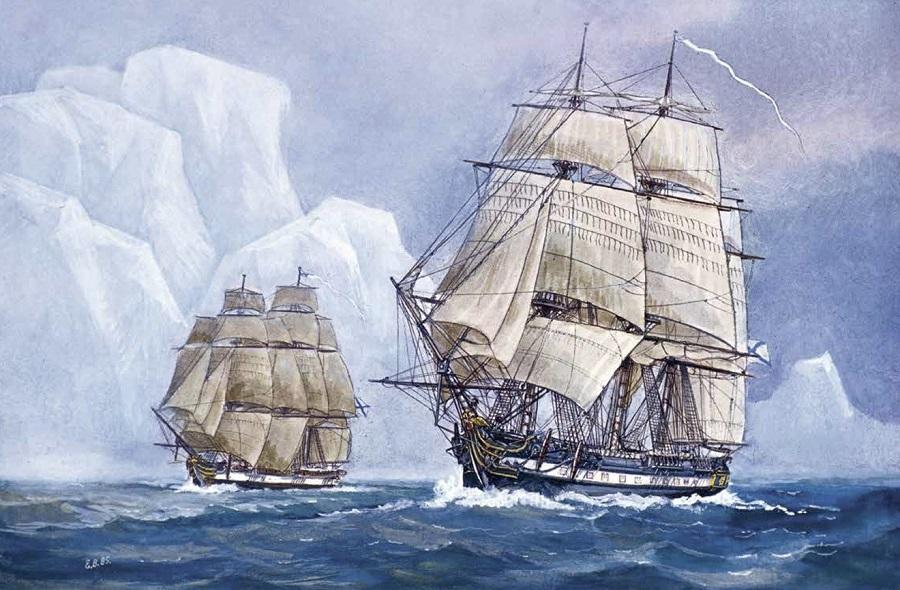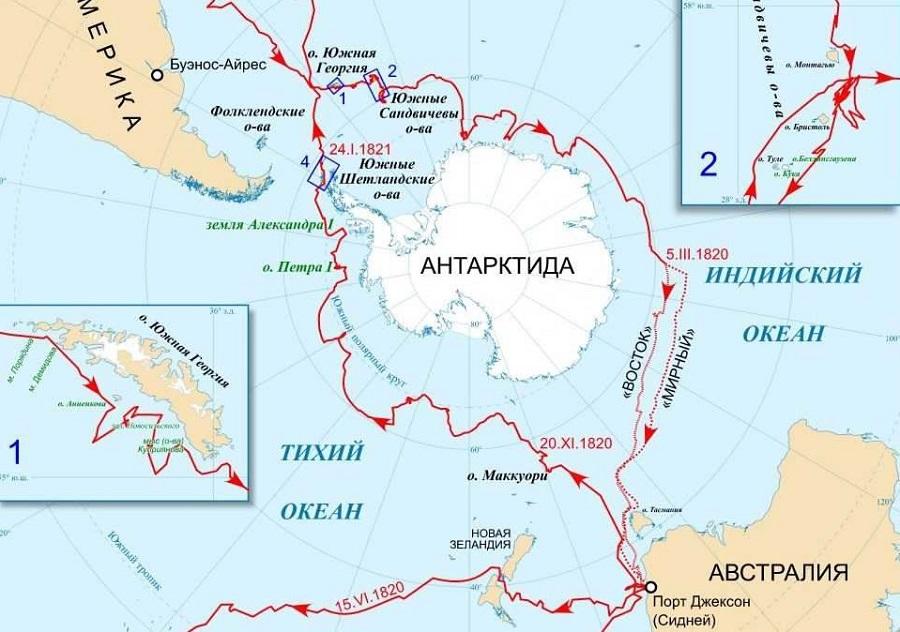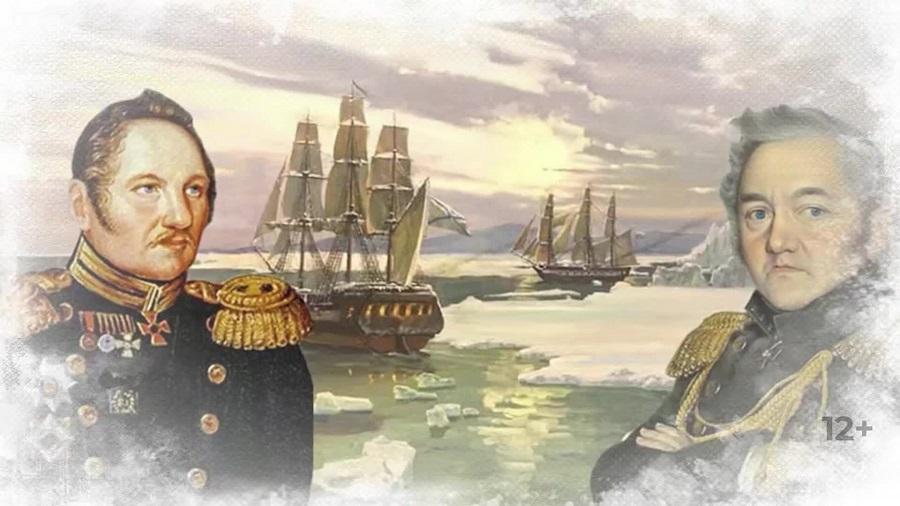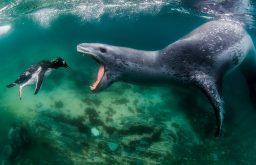
The sloops Vostok and Mirny. Evgeny Voishvillo, Boris Starodubtsev.
The context of the era: the search for the “unknown southern land”
Antarctica has been considered only a myth for centuries. Even ancient philosophers such as Aristotle assumed the existence of an “unknown southern land” — Terra Australis Incognita, which should balance the continents in the north.
However, there was no real evidence of its existence. It was only in the XVIII century that great navigators such as James Cook began exploring the southern latitudes. Cook approached the Antarctic ice in 1773, but never saw the continent. He suggested that if the earth exists, it is almost impossible to get to it because of the ice barriers.
By the beginning of the 19th century, interest in the South Seas had increased. The main goal was not only to test hypotheses about the existence of the earth, but also to search for new fishing zones, fishing territories and strengthen scientific authority in the international arena.
In 1819, Emperor Alexander I commissioned a survey of the south seas. The head of the expedition was Captain 2nd rank Thaddeus Bellingshausen, an experienced navigator, a participant in the first Kruzenshtern circumnavigation. Mikhail Lazarev, the captain of the brig Mirny, no less talented and determined, helped him.
Two ships — the sloop Vostok under the command of Bellingshausen and the sloop Mirny under the command of Lazarev — set off on a long and dangerous journey. The crews numbered about 190 people, including officers, scientists, doctors and sailors. The purpose of the expedition was to explore the southern seas, search for a new land, and observe the climate and nature of high latitudes.
Expedition to Antarctica: a long way

The route of the ships Vostok and Mirny in 1820
The expedition set off from Kronstadt in July 1819. After crossing the Atlantic, the ships passed by Rio de Janeiro and reached the South Atlantic. Already at this stage, the crews faced severe weather conditions — storms, cold, constant dampness.
- The Southern Ocean: an icy challenge.
In January 1820, the expedition entered waters where no human foot had ever set foot before. Temperatures dropped below zero, ships were covered with ice, and visibility was often limited by thick fog. The ice posed a deadly threat: a collision with an iceberg could send the ship to the bottom. - January 27, 1820: the first encounter with Antarctica.
It was on this day that the crew of the Vostok recorded the outlines of the icy coast. Bellingshausen and Lazarev were the first to see Antarctica — not mythical, but real. The coast turned out to be covered with giant glaciers, which reminded of the harsh nature of these places. The places they visited were later named Alexander I Land and Peter I Island.
The expedition lasted for almost three years, and the crews constantly faced incredible challenges and difficulties:
· Harsh climate. The sailors suffered from constant cold, dampness and disease. Clothes and shoes quickly fell into disrepair, and in the conditions of Antarctic winds it was impossible even to dry things.
· Technical problems. The ships of that time were wooden, poorly adapted for sailing among the ice. Icebergs threatened ships at every turn, and maneuvering in such an environment was incredibly difficult.
· Isolation. In the southern seas, the crews were far from civilization, without hope of help. This required incredible endurance from the captains, and dedication from the sailors.
Why did the expedition become a feat?

Faddeus Faddeevich Bellingshausen and Mikhail Petrovich Lazarev
The year 1820 went down in the history of great geographical discoveries as the moment when mankind first saw the mysterious sixth continent — Antarctica. This merit is shared by Russian navigators Faddeus Bellingshausen and Mikhail Petrovich Lazarev. Their expedition was a real feat, despite the harsh weather conditions, technical difficulties and absolute obscurity.
The expedition of Bellingshausen and Lazarev was not only a geographical feat, but also a scientific breakthrough:
- The discovery of Antarctica. Russia became the first country to prove the existence of the southern continent. This has opened a new page in geographical science.
- Exploration of seas and ice. The navigators collected valuable data about the southern latitudes, described icebergs, ice fields and the climate of the region.
- Natural observations. The expedition studied the behavior of seabirds, animals and the peculiarities of ocean currents.
At the same time, advanced technologies were applied. Bellingshausen and Lazarev used the most modern navigation tools of their time, but their success was determined not only by technology, but also by the talent of the commanders themselves. The sailors survived and completed their task in conditions where any mistake could be the last. The discovery of Antarctica was an incredibly important geographical discovery. They crossed the boundaries of the unknown and became symbols of courage and science.
The expedition of Bellingshausen and Lazarev proved that Russia, along with other great powers, participated in the era of geographical discoveries:
· It is a national pride. Antarctica is forever linked with the names of Russian explorers. Their discovery was a reason for pride and a reminder of the courage of our ancestors.
· Outstanding contribution to science. The collected data served as the basis for further Antarctic research and allowed for a better understanding of the climatic processes on the planet.
· The expedition has received international recognition. The work of Bellingshausen and Lazarev was highly appreciated in European scientific circles, becoming a contribution to the development of geography and navigation.
The feat of Bellingshausen and Lazarev is a story about human courage, perseverance and faith in the power of science. They proved that even in conditions of uncertainty, great things can be accomplished if there is a goal and a desire to achieve it. Today, scientific stations, geographical objects and glaciers bear their names.


